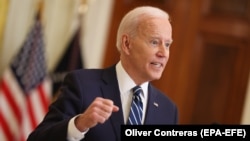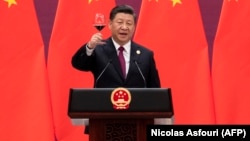
Since it was announced by Chinese President Xi Jinping in 2013, Beijing’s Belt and Road Initiative (BRI) has channeled hundreds of billions of dollars into foreign infrastructure, boosting trade, and clearing the way for China to forge political and economic links around the world.
The massive undertaking -- which Xi dubbed “the project of the century” -- has become a pillar of Chinese foreign policy and a strategic tool for Beijing as it has deepened its partnerships and boosted its influence in the process.
The BRI has since been supported by international organizations and more than 150 countries -- including many in the West -- as it has expanded in scope from ports, pipelines, and roads to include digital technology, health care, and green energy.
But a combination of growing disillusionment among partner countries with the resulting projects, room for more investment, and increased unease about the strategic implications of the BRI might have opened the door for an alternative to emerge.
Ahead of June’s Group of Seven (G7) summit in the United Kingdom, U.S. President Joe Biden has proposed to British Prime Minister Boris Johnson setting up a Western-led infrastructure plan that would rival China’s flagship BRI.
“There is a real opportunity right now. The sheer global need for investment in infrastructure far exceeds the ability of any country to meet it,” Jonathan Hillman, the director of the Reconnecting Asia Project at the Center for Strategic and International Studies (CSIS), told RFE/RL. “Even the most exaggerated estimates of BRI will not meet the world’s needs.”
China will feature prominently on the agenda of the June 11-13 summit, which will bring together the traditional group of Canada, France, Germany, Italy, Japan, United Kingdom, and the United States, plus representatives from Australia, India, and South Korea.
Forming an alternative to the BRI may come into sharper focus as Biden presses ahead with plans to establish an alliance of democracies to counterbalance China’s growing influence.
Biden said in March that he would prevent China from passing the United States to become the "most powerful country in the world," and his administration has outlined plans to boost collaboration with its allies.
The European Union and India already inked a connectivity partnership on May 8 that aims to increase cooperation on digital and hard infrastructure, with an emphasis on strengthening regulatory standards on emerging technologies.
Hillman said the timing is right for advanced economies to offer alternatives to the BRI that can focus on providing more transparency for higher-quality projects across the developing world.
With their combined resources and a growing convergence among allies on how to approach development, especially Brussels and Washington, Western infrastructure plans could receive a boost that they’ve recently lacked.
“The United States is now much more aligned with its European partners when it comes to environmental issues, and that creates more opportunity for collaboration,” said Hillman. “There is a heft and confidence behind these talks that wasn’t there before.”
A Window Of Opportunity
The current push comes as the developing world struggles with the economic pressures brought by the pandemic and as the BRI brand has been tarnished by controversy.
The World Bank has said that COVID-19 will plunge the world economy into the worst recession since World War II and the world’s infrastructure needs -- estimated at $94 trillion over the next two decades -- are still unmet.
The BRI has also been undercut in recent years with questions regarding the commercial value of many of its projects, growing debt worries over murky lending practices, and concerns over the initiative being a vehicle for Chinese control.
Montenegro asked the European Union in April for help repaying a $1 billion Chinese loan for an ongoing highway project in that small Balkan country.
Debt and transparency concerns also surfaced in May as Hungary announced a $1.5 billion loan to build a Chinese university. This followed a controversial move by the government in April 2020 to keep all details classified around $1.9 billion borrowed from China for a railway project connecting Budapest to Belgrade.
Wider aspersions have been cast on the terms of deals for BRI projects, which a recent study of 100 Chinese contracts by the Center for Global Development found contained uniquely restrictive secrecy requirements and clauses that could allow Chinese entities to influence the policies of debtor countries.
WATCH: Plans For Chinese University In Hungary Prompt Concerns Over Influence
“The shine is now gone from the [BRI],” Theresa Fallon, the director of the Center for Russia Europe Asia Studies in Brussels, told RFE/RL. “Positions towards China have been hardening and this is a chance for Europe to start thinking more strategically in their own neighborhood and beyond.”
The terms of what a Western alternative could look like are still being discussed but will likely seek to build off past agreements and rely on a mix of public and private funds.
The European Union launched a connectivity plan in 2018 and signed a deal with Japan in 2019 in what former Japanese Prime Minister Shinzo Abe called a “sustainable, rules-based connectivity from the Indo-Pacific to the Western Balkans and Africa.”
The United States also passed the Build Act in 2018, which is intended to boost investment from the private sector in the developing world, and also launched the Blue Dot Network with Japan and Australia in 2019 as a way to uphold standards for infrastructure projects.
None of the initiatives, however, has yielded much in terms of concrete results, raising concerns that the West is unable to offer a true alternative to the state-backed economic vision put forward by Xi.
According to Fallon, Western nations should not be focusing on matching Beijing in terms of the volume of financing, but should instead be looking to use an infrastructure push to help spread higher standards for executing projects and integrating more transparency into contract negotiations.
“Simply being present on the ground already increases the leverage on China by making them have to improve what they offer and be more transparent in order to compete,” said Fallon.
A Patchwork Of Projects
While efforts to come up with alternatives to the BRI are gaining steam, they also face growing obstacles.
Western countries currently lack a centralized point to coordinate infrastructure partnerships. This makes it unlikely that one unified initiative to rival the BRI will materialize. Instead, analysts say, any future Western initiatives are likely to remain a mix of separate but coordinated projects between various players like the United States, the European Union, Japan, and India.
“Political interest around this is moving, but actually pulling an alternative together and showing what it looks like is not developed yet,” Andrew Small, a fellow with the German Marshall Fund in Berlin, told RFE/RL. “It’s been hard enough for each country’s system to do this on their own, let alone to get them all to cooperate and coordinate together.”
Another potential obstacle is funding. While public institutions from G7 nations can step in to provide funding, a large amount of financing would need to come from the private sector, which is traditionally hesitant to get involved in large-scale infrastructure projects.
Moreover, many players are also cautious about setting up initiatives that would be seen as direct rivals to BRI or anything that could be seen as an anti-China alliance.
Rather, said Daniel Markey, a professor at Johns Hopkins University and a former State Department official, any future alternative should be looking to make partnerships based on shared standards and norms.
The growth of China’s domestic tech companies through the BRI has allowed them to take up a dominant position across the world and with that allow Beijing to set the standards for many next-generation technologies. Markey said that any alternative initiative should look to focus on crucial sectors instead of simply investing broadly in infrastructure.
“Rather than crafting a direct response to BRI, Washington's approach should play to the strengths of the United States and its allies rather than attempting to beat China at its own games or on its home turf,” he said.















